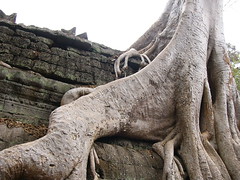 Faraway Land
Faraway Land
Brown, blue and grey – those to me were the colours of Ladakh. The Uttaranchal Himalayas were lush and verdant. Ladakh is barren desert and mountainscape, an expanse of craggy snow-covered peaks and muddy deep rivers. The silence-filled expanse is magnificent and mysterious. It feels like few people have walked these lands before.
The Indus was the river we followed on its course. The Indus that gave India and a whole civilization its name, the Sindhu of our puranas, the main water resource of the Punjab and Sindh provinces of Pakistan. We saw it in its upper reaches, closer to its glacier source. So it is muddy and brown and unlike the Alaknanda of Uttaranchal, much less frisky and playful. The white water rafting on the Indus was exciting but not scary – the rapids not being so wild and untamed.
The mentions of height above sea level are casual and matter-of-fact – Leh is at 12,000 ft, mountain passes at 17,000 and 18,000 feet. To a plains-dweller, that is pretty awesome. A little reflection and you realize you are talking of 2/3rds the height of Mt. Everest, the height of the tallest mountains in Europe, higher than any in North America. And a car gets you there! Khardung La, the highest point we got to is one of the highest motorable passes in the world. We got there on a cold and snowy day and the mountain views were truly memorable. But it is quite difficult to imagine being posted in a place like that. The Indian Army guys have it pretty tough.
The Indian Army is ubiquitous in Ladakh. The proximity to the borders (of both Pakistan and China) is evident by their presence. And probably because of this the roads are pretty good, especially the mountain roads. The locals seem happy to have the Army there – they provide employment, build roads and keep them safe. Though I am sure there are bound to be conflicts with the local administration. The Kargil war is still a close memory and when we were on the Leh-Srinagar highway, on our way to Lamayaru, we were reminded of how close Pakistan was to being able to shut out this road.
We were in Ladakh for about 10 days and there was no way we could escape the gompas of the land. These are ancient monasteries and quite like the temples of south India, have managed to withstand foreign intrusions into the land. Most of these gompas are situated on cliff tops and though these days roads can take us up to most of them, in ancient times, these might have been quite inaccessible, adding to their mystique. The Diskit monastery in the Nubra valley is a pretty gompa with some stunning views as is the Rizong one on the way to Lamayaru. The Shankar Gompa in Leh is pretty disappointing but the Likir one has this massive statue of the Buddha that looks out into the countryside. The wall murals and the ancient thankas inside these temples are beautiful works of art – treasures that we need to protect.
Leh itself has little of great interest. It is a capital town, overflowing with tourists from abroad. Tibetan shops and people are everywhere and its main market roads are pretty crowded and noisy. But it’s a nice place to stay for a couple of days to get away from the heat of the plains. Leh palace is in ruins and though it is supposed to be modeled on the Potala palace of Tibet, has little to really distinguish itself.
The Nubra Valley on the other hand is truly unique, with the Shyok river running through it. Sand dunes in the midst of snow-capped mountain peaks is a rather distinctive landscape. It is like a Rajasthan has been transported to the Himalayas. Geographically speaking, it is not really an anomaly. The mountains form a blockade against rain giving clouds and hence much of Ladakh is really a desert. The Nubra valley and its thinly populated expanse though will remain in memory for quite a while. We did not see a single soul on our 8 km walk from the Hunder to the Diskit village. It was just the mountains, sand and us.
Pangong Tso, the lake that lies on India’s border with China provides yet another mind-numbingly scenic landscape in Ladakh. Only one-third of the lake lies in India, yet it seems pretty big. The blue-ness of the water and the sky is so beautifully set off by the brown of the mountains and the land. And the different shades of blue in the water can let you stare at it for hours. Getting there through Chang La, yet another impossibly high pass is an adventure by itself.
Ladakh was an experience to remember. Rarely have I seen such true scenic beauty. We went there in the height of summer, when there was hardly any snow and ice. Ladakh in winter would be impossibly tough yet impossibly beautiful as well, I am sure.



